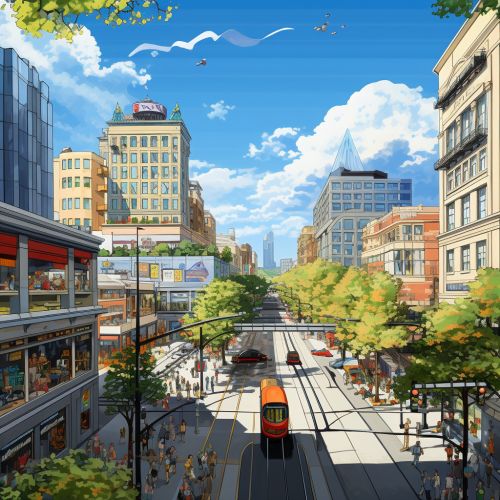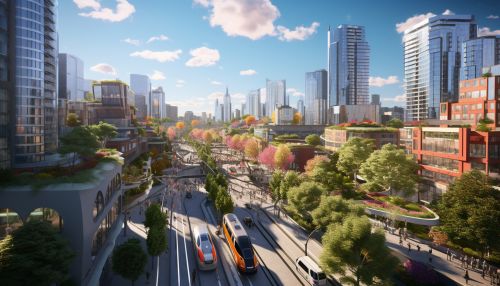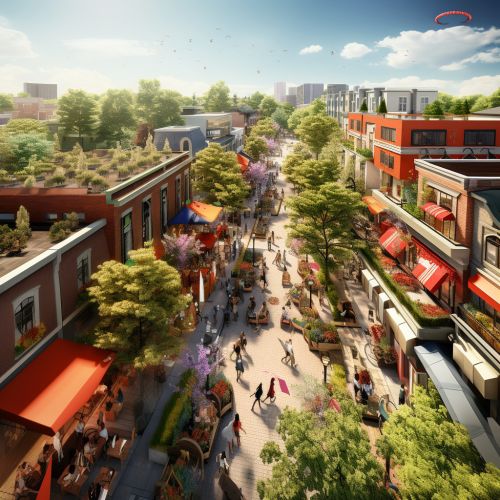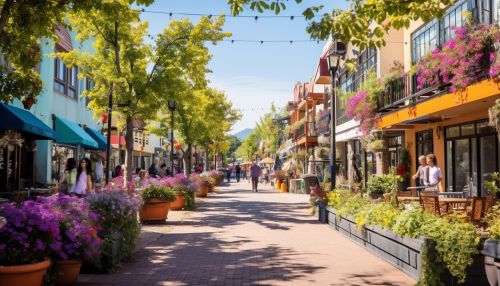Smart growth
Introduction
Smart growth is a concept in urban planning that emphasizes compact, transit-oriented, walkable, bicycle-friendly land use, including neighborhood schools, complete streets, and mixed-use development with a range of housing choices. The term "smart growth" is particularly used in North America. In Europe and particularly the British Isles, the equivalent term is "sustainable urban development".Learn more
History
The concept of smart growth evolved from a variety of earlier urban planning movements. Urban renewal, regionalism, the garden city movement and historic preservation all influenced smart growth's goals. In the 1970s and 1980s, the environmental movement also embraced urban planning. Several cities and states began to draw up urban planning policies based on these principles.


Principles
Smart growth principles aim to achieve a unique sense of community and place; expand the range of transportation, employment, and housing choices; equitably distribute the costs and benefits of development; preserve and enhance natural and cultural resources; and promote public health.
Community and Sense of Place
Smart growth emphasizes the creation of a unique sense of community and place. This is achieved through the promotion of design standards and architectural styles that reflect community values, history, and culture, as well as the use of mixed-use development and land recycling to promote community identity and vitality.
Transportation, Employment, and Housing Choices
Smart growth promotes an expanded range of transportation, employment, and housing choices. This includes the promotion of transit-oriented development, which encourages the design of neighborhoods around public transportation stations. This principle also encompasses the promotion of a variety of housing types to meet the needs of a diverse population.
Equitable Development
Smart growth seeks to equitably distribute the costs and benefits of development. This includes ensuring that all communities share the benefits of economic development and redevelopment efforts. It also involves making sure that the costs of development, such as increased traffic or loss of open space, are not borne disproportionately by a single group, particularly low-income communities.
Preservation of Natural and Cultural Resources
Smart growth aims to preserve and enhance natural and cultural resources. This includes promoting development practices that conserve green spaces, protect air and water quality, and preserve critical environmental areas. It also involves promoting the use of historic buildings and districts for new purposes as a way of preserving cultural resources.
Public Health
Smart growth promotes public health by encouraging active living and reducing exposure to pollutants. By promoting walkable neighborhoods and reducing dependence on cars, smart growth can encourage physical activity and reduce obesity rates. By promoting development practices that conserve natural resources and reduce pollution, smart growth can also improve air and water quality, reducing exposure to environmental health hazards.
Benefits
Smart growth can provide a variety of benefits, including economic, environmental, and health benefits. Economically, smart growth can increase property values, reduce infrastructure costs, and promote economic development. Environmentally, smart growth can conserve natural resources, reduce pollution, and promote sustainability. From a health perspective, smart growth can promote active living, reduce obesity rates, and improve air and water quality.


Criticisms
Despite its benefits, smart growth has also been subject to criticism. Some critics argue that smart growth can lead to gentrification, displacing low-income residents. Others argue that smart growth can restrict personal freedom by limiting housing choices and forcing people to live in denser urban areas. Some critics also question the effectiveness of smart growth in reducing traffic congestion and improving air quality.
Future Directions
As urban populations continue to grow, the principles of smart growth are likely to become increasingly important. Future directions for smart growth may include a greater emphasis on resilience to climate change, the integration of smart technologies into urban planning, and the promotion of social equity in urban development.
